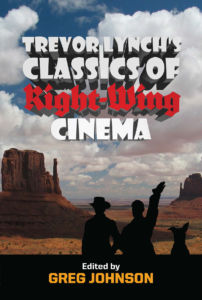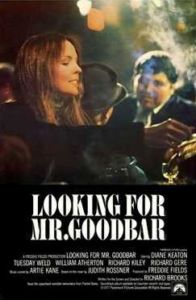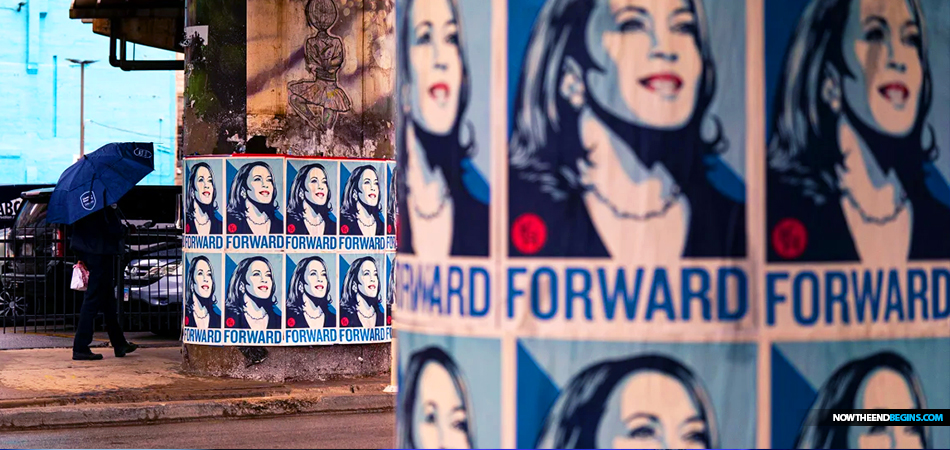Looking for Mr. Goodbar: A Tale of Disco-Era Debauchery
Looking for Mr. Goodbar is a lesser-known 1970s Diane Keaton film, but that does not really say a lot when you consider that her well-known films from that decade include all-time classics such as The Godfather films and Woody Allen’s glory-years entries such as Annie Hall. Add to this the fact that Looking for Mr. Goodbar has been notoriously difficult to find. While it is occasionally shown on TV, it has never been released on DVD or Blu Ray and is not available on any streaming service due to music licensing issues arising from its disco-era soundtrack. But the film made a splash when it was released in 1977 and even had the distinction of being the movie that ended Star Wars’ 15-week run at the top of the box office.

Looking for Mr. Goodbar is about Theresa Dunn, an Irish Catholic woman living a double life as a dedicated teacher of special needs first-graders by day, while she is a bar-hopping, pill-popping floozy at night who cruises the shadier Chicago dives looking for random sexual encounters while developing an unhealthy taste for the hip, new era-defining drug: cocaine. Rather than being an all-time classic, Looking for Mr. Goodbar is an of-its-time classic. It is set in the disco era, when the seeds of the sexual revolution that had been sown in the 1960s were starting to bear fruit. The picture that was beginning to emerge was not a pretty one.
The film was based on the New York Times bestselling novel of the same name, which was in turn based on the real-life murder of Roseann Quinn in 1973. Roseann Quinn was a New York schoolteacher who was murdered by a man who she brought home from a singles bar. The Quinn murder became something of a cause célèbre for conservatives at the time, who held it up as a cautionary tale about the dangers of female sexual liberation and an example of what might happen to bad girls who reject the traditional path of marriage and motherhood.
Director Richard Brooks had been around since Hollywood’s Golden Age, when he wrote and/or directed films starring Humphrey Bogart, Burt Lancaster, and Bette Davis. Arguably, Brooks’ most culturally significant film was Blackboard Jungle, which is famous for being the first movie to have rock ‘n’ roll music on its soundtrack and is credited with bringing the emerging genre to the mainstream. The film’s theme song, “Rock Around the Clock” by Bill Haley and His Comets, who are sometimes considered the first white rock stars, shot to #1 on the pop charts as a result of the movie — the first rock ‘n’ roll song to do so.

As Looking for Mr. Goodbar opens, Theresa is still in college and in the midst of an affair with her married college professor, Martin. While she worships the ground Martin walks on, he is devoid of warmth and is loath to express any genuine affection to his co-ed concubine. Martin breaks off the affair after Theresa attempts to call him at home. It is implied that Martin will inevitably move on to the next smitten co-ed, and Theresa is left feeling used and humiliated. Having become disillusioned with romance, and now “damaged goods” marriage-wise, Theresa decides to embark on a lifestyle of casual sex with strange men.
Theresa does not do so randomly. The film provides us with some psychological motivations for her actions. Theresa had scoliosis as a child, which resulted in her having to be in a full body cast for a year, and the corrective surgery left her with an unsightly and unsexy scar. Later she learns that the condition is hereditary, and that there is a possibility that if she has a child that the kid might have to go through the same ordeal. Moreover, Theresa grew up as the mousy younger sister of Katherine, a natural sexpot who attracted male attention effortlessly. Theresa thus developed something of an inferiority complex. When we first meet her sister Katherine, she is pregnant and unsure who the father is, as she has been having multiple affairs. Katherine is played Tuesday Weld, who received a Best Supporting Actress nomination for her performance.

Theresa moves out of her parents’ house and begins a new double life where she is both Madonna and whore. By day, she is a saintly schoolteacher of deaf children who is willing to go the extra mile to help the little tykes achieve their fullest potential. By night, she picks up men in men in bars, and as the film progresses, both the men and the bars become shadier and more disreputable. The men she picks up are usually not strapping young chads, but older men, suggesting that she is attracted to father figures (Theresa’s lousy relationship with her dad is a major subplot). By the end, she is picking up men in gay bars. One sexual encounter ends with a man leaving money on the counter, apparently believing that he just had sex with a prostitute.

You can buy Trevor Lynch’s Classics of Right-Wing Cinema here.
Her ability to keep these worlds apart begins to deteriorate. One night, she takes a Quaalude to get to sleep after binging on cocaine, which results in her being late for work. Her apartment also becomes infested with cockroaches, as she becomes disinterested in doing even basic housecleaning.
While an endless parade of men come in and out of Theresa’s apartment and nether regions, there are two men who become a regular presence in her life. One is James, played by William Atherton, who is an Irish Catholic welfare caseworker, and genuine “husband material.” Theresa meets James as he is about to cut off welfare support to one of her students’ parents, which would result in the family’s eviction and her student’s withdrawal from school. Theresa starts dating James with the intent of manipulating him into giving more favorable treatment to the family, and for a time, it looks like Theresa might be able to use her whorish powers for good. But James wants a traditional courtship with no sex before marriage. As Theresa becomes desensitized to the degenerate lifestyle, she has difficulty managing a normal, healthy romantic relationship, and she comes to resent James for his patriarchal expectations of her.

The other semi-constant in Theresa’s life is Tony, a rakishly handsome Italian street hoodlum played by gerbil enthusiast Richard Gere in his breakout role. Tony is anti-social, unpredictable, and unreliable, and is most definitely not relationship material. Tony is also prone to disappearing for extended periods of time to engage in a life of petty crime, only to then show up without warning, expecting sex. Theresa is nevertheless intrigued by Tony’s snaky charisma and unpredictability.
James and Tony are obviously meant to be foils. James represents safety and stability, while Tony symbolizes spontaneity and danger. And yet, both men come to resent that Theresa will not be the woman they want her to be. James is frustrated that Theresa will not be the perfect housewife, living out her traditional gender role, and Tony is frustrated that she will not become the perfect slut, available for his exclusive sexual use on his erratic whims. Both become increasingly possessive and take to stalking Theresa, which only causes her to withdraw more.

After Tony starts making idle threats, Theresa become paranoid that he will call the police on her – and then they will discover the assortment of drugs stashed around her apartment. She flushes all the drugs down the toilet and resolved to retire from the floozy lifestyle in the new year. But before that, she goes on one more night of cruising on New Year’s Eve. On this night, she meets the mentally ill repressed homosexual Gary, who she takes home. After he is unable to achieve an erection, Theresa asks him to leave. Gary interprets this as Theresa questioning his sexuality, leading to him becoming unhinged. He rapes and murders Theresa by strobe light.
While considered a drama at the time, the ending has caused some people to label Looking for Mr. Goodbar a horror movie. In fact, no less than Stephen King ranked it at #6 on his list of scariest movies.
Looking for Mr. Goodbar received mixed reviews at the time. Much of the criticism was due to the film’s deviations from the novel, which significantly change the story’s meaning. In his review of the film, Roger Ebert explains the difference:
There’s one crucial thing that Looking for Mr. Goodbar doesn’t make clear: Just because you find Mr. Goodbar doesn’t necessarily mean you were looking for him. The heroine of Judith Rossner’s bestseller was looking. Theresa was turned on to a particular flavor of self-destructive sexual experience, one involving possible danger to herself, and she played a role in bringing about her own death. In Richard Brooks’s film version, that masochistic impulse isn’t considered as openly. He gives us a Theresa who drinks too much, sleeps around too much, and takes too many drugs — but she seems more of a hedonist than a masochist. She’s looking for a combination of good times, good sex, and a father figure, for psychological reasons the movie makes all too abundantly clear. But she isn’t looking for danger, mistreatment, or death.
There were also some grumblings from liberals that the movie engaged in some slut-shaming and victim blaming. The message is that the heroine died as a result of embracing her sexual independence; if she had followed the standard patriarchal norms of marriage and motherhood, she would still be alive.
46 years after its premiere, Looking for Mr. Goodbar still packs a punch. When it was released, the sexual revolution was in its infancy and casual sex outside of marriage was a novelty. The first “singles bar” was opened in 1965. Nowadays, hookup culture is ubiquitous, and so you would think that Looking for Mr. Goodbar would seem more pedestrian to us nowadays than it is. It is in fact because the film was the product of a more traditional society that it is more harrowing. Diane Keaton’s character rejects her traditional Catholic upbringing to become a slut, which makes the story more tragic than if it were a modern retelling featuring a woman who becomes a slut because she had no tradition to reject and doesn’t know any better.
* * *
Counter-Currents has extended special privileges to those who donate at least $10/month or $120/year.
- Donors will have immediate access to all Counter-Currents posts. Everyone else will find that one post a day, five posts a week will be behind a “paywall” and will be available to the general public after 30 days. Naturally, we do not grant permission to other websites to repost paywall content before 30 days have passed.
- Paywall member comments will appear immediately instead of waiting in a moderation queue. (People who abuse this privilege will lose it.)
- Paywall members have the option of editing their comments.
- Paywall members get an Badge badge on their comments.
- Paywall members can “like” comments.
- Paywall members can “commission” a yearly article from Counter-Currents. Just send a question that you’d like to have discussed to [email protected]. (Obviously, the topics must be suitable to Counter-Currents and its broader project, as well as the interests and expertise of our writers.)
To get full access to all content behind the paywall, please visit our redesigned Paywall page.




